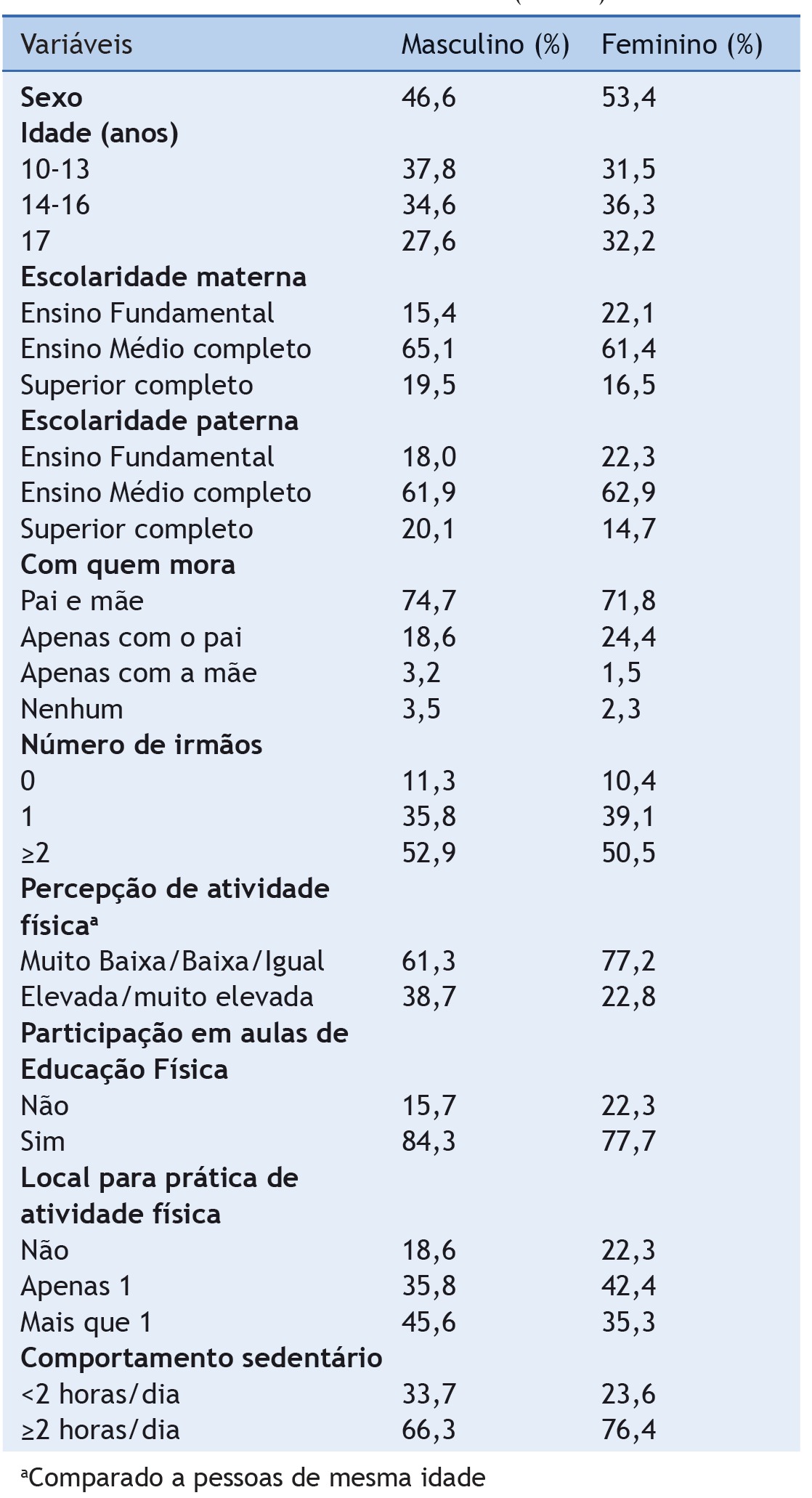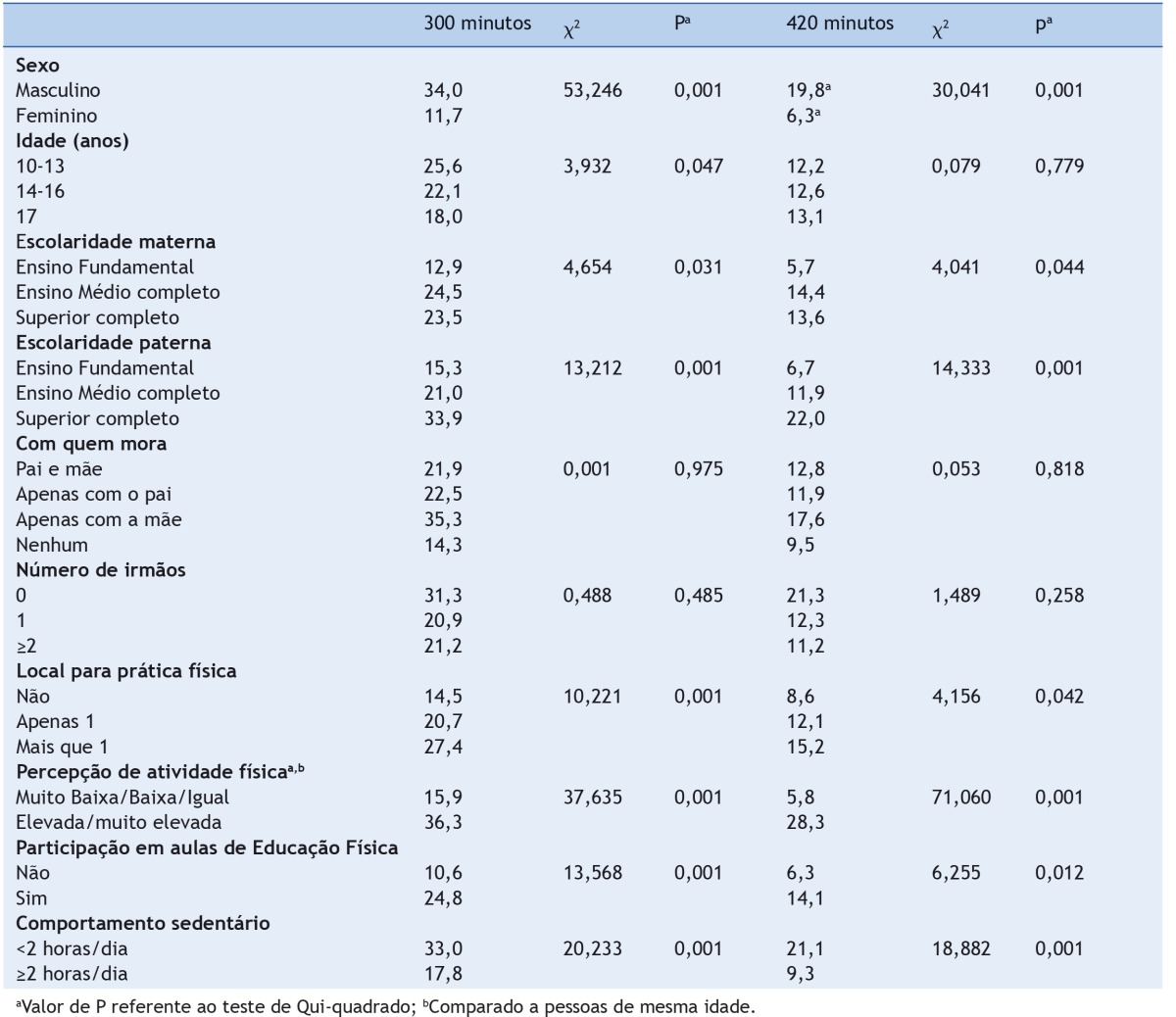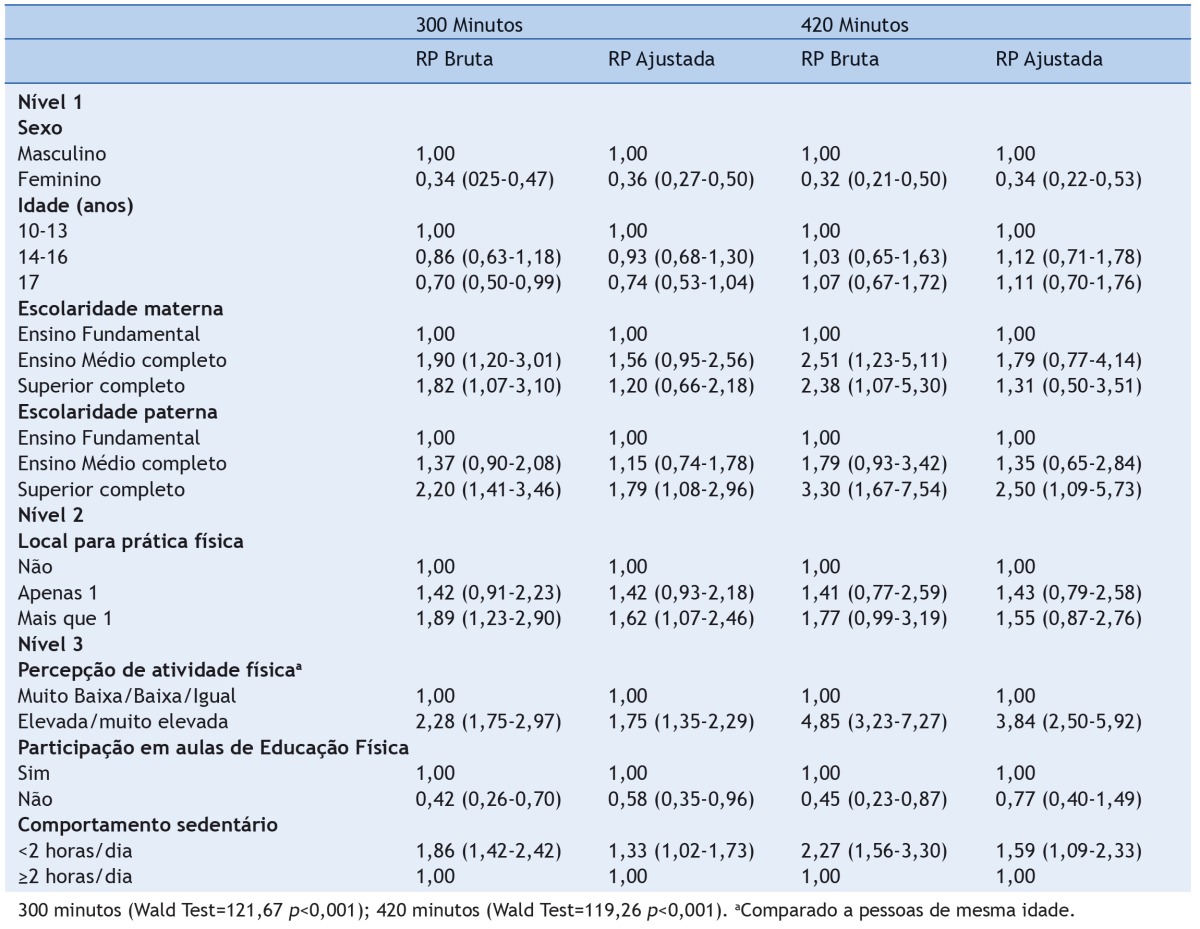Abstract
Objective:
To analyze the agreement between two cutoff points for physical activity (300 and 420 minutes/week) and associated factors in youth.
Methods:
The study enrolled 738 adolescents of Londrina city, Paraná, Southern Brazil. The following variables were collected by a self report questionnaire: presence of moderate to vigorous physical activity, gender, age, father and mother education level, with whom the adolescent lives, number of siblings, physical activity perception, participation in Physical Education classes, facilities available to physical activity practice and sedentary behavior. Prevalence of physical activity between criterions were compared using McNemar test and the agreement was analysed by Kappa index. Multivariate analysis was performed using Poisson regression with robust variance adjustment was applied.
Results:
The prevalence for physical activity was significantly different: 22,3% for 300 minutes/week and 12,8% for 420 minutes/week (p<0,05), but the agreement was strong (k=0,82, p<0,001). The variables gender, father education, physical activity perception and sedentary behavior were associated to physical activity in both analyzed criteria. Participation in Physical Education class and facilities available to physical activity practice were associated to physical activity only with 300 minutes/week cutoff point.
Conclusion:
Caution is suggested regarding cutoffs use for physical activity in epidemiological studies, considering they can result in differences in prevalence of physical activity and its associated factors.
Keywords: Adolescent, Motor activity/criteria, Public health
Introduction
Physical activity has been investigated in different age groups due to its positive association with health.1 The recommendation for physical activity for children and adolescents is 60 minutes at a moderate-to-vigorous intensity, at least five days a week, and performing more than this daily can produce additional health benefits.2 Therefore, active adolescents have a better cardiometabolic profile and a higher degree of physical fitness related to health, mental health, and nutritional status.3 - 5
In Brazil, several epidemiological studies have been performed to identify the prevalence and factors associated with physical activity among adolescents. The prevalence of physical activity ≥300 minutes/week in Brazilian adolescents from different regions of the country ranges from 14.5% to 50%.6 - 12 Due to the low prevalence of young individuals who meet the recommendations of weekly physical activity, several studies have sought to identify factors associated with physical activity in this age group. In general, the factors positively associated with physical activity of young Brazilians are male gender,7 , 9 , 10 , 13 socioeconomic status,9 maternal and paternal education,8 and participation in physical education classes,7 - 9 while sedentary behavior,9 , 11 , 13 work,7 age,9 and night study12 are factors negatively associated with physical activity.
Concerning the level of weekly activity by adolescents, although there is a recommendation of performing moderate to vigorous physical activity for 60 minutes daily, and because performing 60 minutes daily produces additional benefits,2 studies have used 300 minutes/week as the cutoff,6 - 9 , 11 , 12 , 14 as well as 420 minutes/ week.5 , 13 , 15 - 19
Nevertheless, it is not known whether using different cutoffs for physical activity among young individuals results in similar prevalence and factors associated to physical activity.
The absence of information that show the association between the cutoff and the factors associated with physical activity have resulted in the use of different cutoffs in epidemiological studies, a fact that hinders the interpretation of results.20 Thus, the objectives of this study were: a) to analyze the agreement between two cutoffs (300 and 420 minutes) regarding the prevalence of active young individuals, and b) to identify factors associated with physical activity in each cutoff.
Methods
This was a cross-sectional study of children and adolescents from the public schools of the city of Londrina, state of Paraná, Brazil, carried out in the second quarter of 2012. According to a survey by the Regional Education Center, 55,475 children and adolescents were enrolled from the sixth grade of elementary school to the third year of high school in the public schools of the city in 2012.
The probabilistic method was used to select the sample by means of two clusters (school and series), stratified by city region (North, South, East, West, and Central) and by gender, performed in two stages. In the first stage, a school was randomly selected from each region. Secondly, the number of students in each school was evaluated, in order to obtain the proportion that the region represents. No participant had any physical or cognitive limitations that could prevent performing the study procedures.
To calculate the sample size, the following parameters were used: population of 55,475 school children, prevalence of outcome 35%,7 confidence interval of 95%, and sampling error of 5%. Thus, the minimum required sample size was 347 students. In order to increase the precision of the estimates, given that the present study used complex sampling, a design effect (Deff) of two was applied to sample size, producing a total of at least 694 students.
The present study evaluated 965 students, with a final sample of 738 participants, as data was only analyzed from subjects who completed the questionnaire correctly. There was a loss of 23.5%, and individuals who did not complete the questionnaire were 50% females. Regarding age, 48.6% were 10-13, 37.2% were 14-16, and 14.2% were 17 years of age; 24.3% met the criterion for physical activity of 300 minutes/week, and 13.5%, the criterion for 420 minutes/week.
The study was approved by the Ethics Committee of Research on Human Subjects of Universidade Estadual de Londrina, protocol No. 312/2011, according to Resolution 196/96 of the National Health Council. All parents/guardians of the students who agreed to participate signed the informed consent, which described all the procedures that would be performed and provided contact information to clarify possible questions. At the end of the study, the results were presented to each school through individual reports.
All procedures were performed in the classrooms of the schools on a single day, by five trained researchers supervised by the study coordinator. The dependent variable, moderate-to-vigorous weekly physical activity, was assessed by section 2 of the physical activity questionnaire proposed by Baecke et al in 1982,21 which estimates the amount of physical activity through sports or physical exercise programs according to the activity intensity.
The criteria used concerned the recommendation of physical activity in young individuals: 60 minutes of moderate-to-vigorous physical activity at least five days a week (300 minutes), and 60 minutes daily (420 minutes).2
Participants reported gender and date of birth in the questionnaire, which were verified through the students' list of the Regional Education Center. The independent variable, paternal and maternal education, was established by the question about the educational level of the household head contained in the Associação Brasileira de Empresas de Pesquisa (ABEP) 2012 questionnaire.22 The perception of physical activity was estimated using the question "Compared to other people of the same age, do you believe that the activities performed during your free time are physically very high, high, equal, low, or very low?".21
The number of siblings was estimated through the open question "How many siblings do you have?" To analyze the persons with whom the participant lived, the question used was "Who do you live with?", and the response options were "With my father and mother", "only with my mother" "only my father", and "Neither". The availability of places to practice physical activity nearby home was assessed by the question "In your neighborhood, is there an adequate place (square, park, court, field, or club) for you to play or practice any sports?" with response options "No", "Yes, just one", and "Yes, more than one."
Given that the curriculum of the state schools in Paraná includes two physical education classes a week, information on class participation was obtained through the question "Do you participate in physical education classes?", with possible responses "Yes, both", "Yes, just one", and "No". The results were dichotomized into "yes" to those who claimed to attend two classes per week, and "no" to those who participated in only one or did not participate in the classes.
Sedentary behavior was estimated by the question "How many hours on average do you watch TV, play video games, or use the computer?" With response options "<1 hour each day", "1 hour each day", "2 hours each day", "3 hours each day", "4 hours each day", and "5 or more hours each day" during weekdays. Responses were dichotomized as ≤2 hours/day or >2 hours/day.23
The reliability of the questionnaire used in this study was tested on 70 schoolchildren, within a seven-day interval. For categorical variables, all questions showed acceptable reliability, with question agreement tested using the Kappa index ranging from 65% to 100% between the two moments. For the number of siblings, a discrete numerical variable, the reliability was high, with intraclass association coefficient =0.964 (0.926-0.983).
Absolute and relative frequencies were used for the descriptive statistics. To assess the bivariate association between the independent variables and the two criteria for moderate-to-vigorous physical activity, the chi-squared test (χ2) was used. The variables that showed an association of up to 20% were included in the multivariate analysis, performed by Poisson regression with robust variance adjustment to estimate the prevalence ratios and respective 95% confidence intervals.
The variables were included in the model in three hierarchical levels, adjusted for the variables of the same level and the level above. At level 1 the variables gender, age, and maternal and paternal education were inserted; at level 2, the variable place available for physical activity was inserted; level 3 included the variables perceived physical activity, participation in physical education classes, place for physical activity, and sedentary behavior. The complex sample model was considered according to the sample cluster.
The McNemar test was used to compare the prevalence rates between the criteria. To analyze the agreement between the criteria of 300 and 420 minutes/ week, as well as the questionnaire reliability, the Kappa index was applied, adjusted by prevalence and interpreted in accordance with the classification: <0=poor; 0-0.20=weak; 0.21-0.40=reasonable; 0.41-0.60=moderate; 0.61-0.80=strong; 0.81-1.00=almost perfect. In all cases, the significance was set at 5%.
Results
The sample characteristics are described in Table 1. The study sample consisted of 738 children from the public school system; 53.4% were females. With regard to age, the largest proportion of males was aged between 10 and 13 years, and for females, 14 to 16 years. Most young individuals had parents with high school education, lived with both parents (father and mother), and had ≥2 siblings. Regarding the perception of physical activity in relation to individuals of the same age, both boys and girls perceived themselves as below or equal, participated in physical education classes, and had sedentary behavior >2 hours/day. Among males, a higher proportion of individuals reported having more than one place for physical activity practice, while females reported having only one.
Table 1. Sample characteristics (n=738).
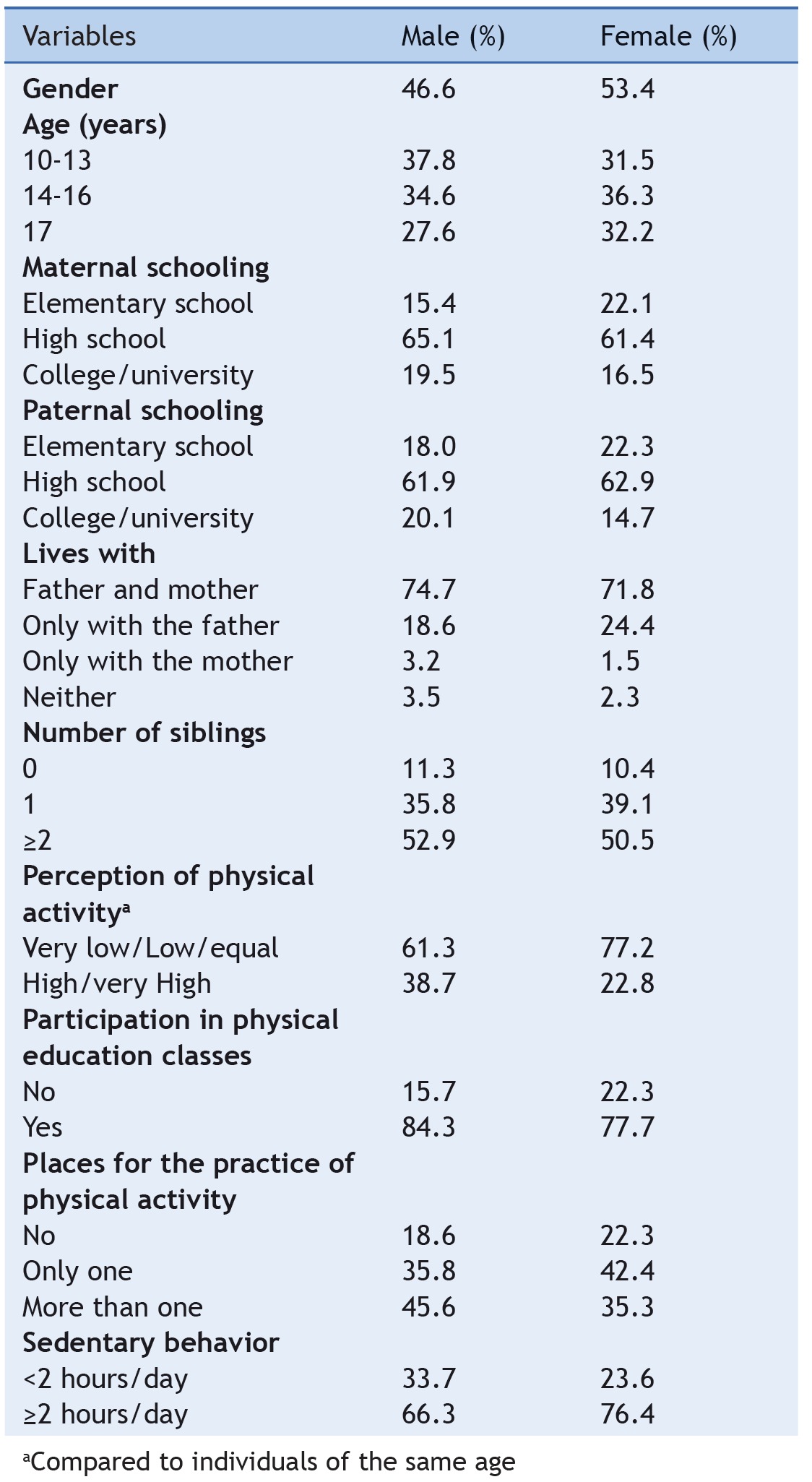
The results concerning the bivariate analysis of the association between meeting the criteria of physical activity and the independent variables, as well as the comparison of prevalence between the criteria are described in Table 2. A significant difference was found in prevalence rates between the two criteria (22.1% for 300 min vs. 12.6% for 420 min, p<0.05). The variables gender (male), maternal and paternal education, physical activity perception, participation in physical education classes, and number of places to practice physical activity were positively associated, while sedentary behavior was negatively associated with physical activity in both criteria (p<0.05). Age was associated only with the criterion of 300 min. The agreement of the prevalence of meeting the physical activity recommendation was considered strong, with k=0.816, p<0.001, agreeing in 90.5% of cases.
Table 2. Prevalence of meeting the recommendation of moderate-to-vigorous physical activity of 300 and 420 minutes/week according to the independent variables analyzed.
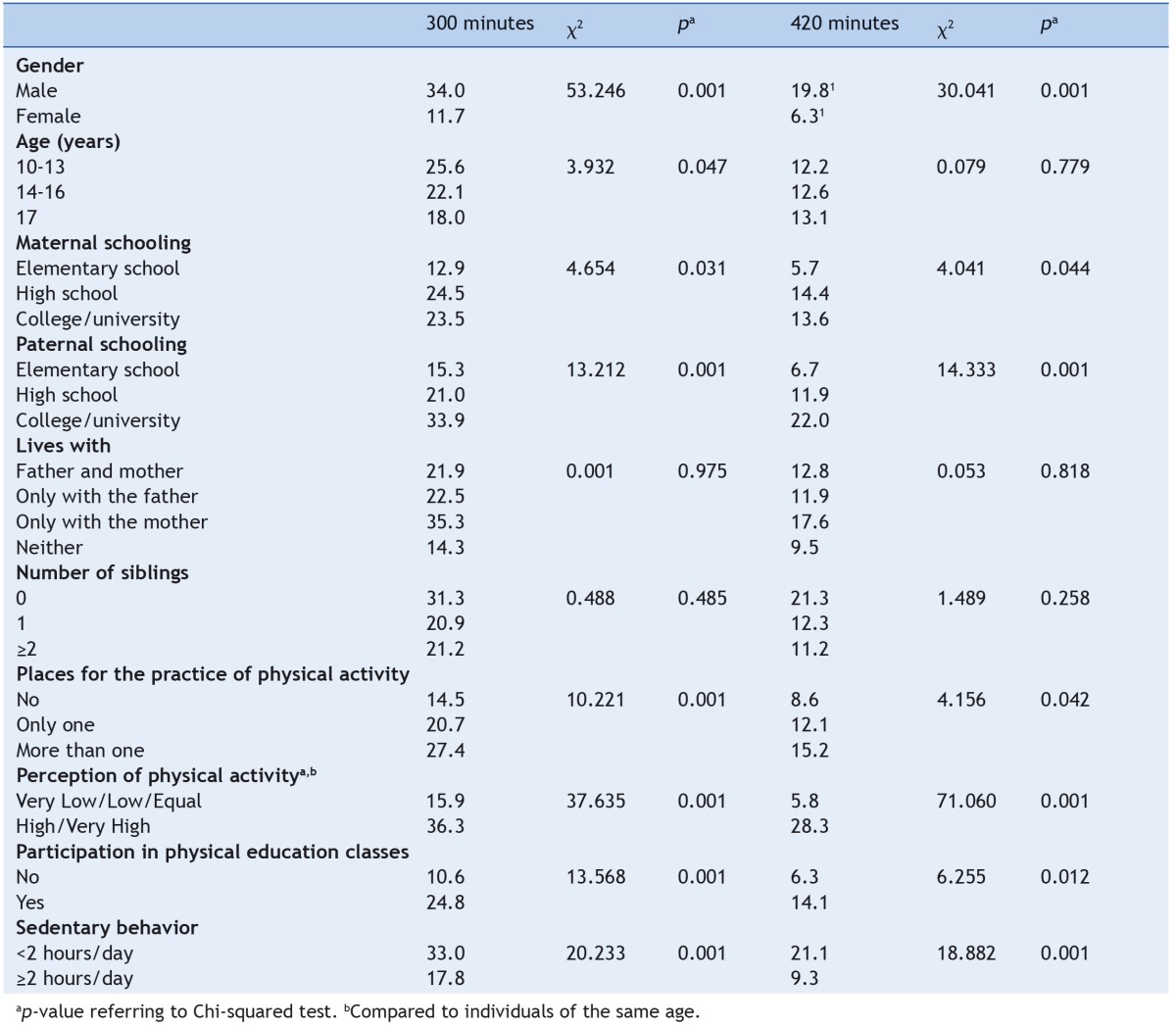
Table 3 presents the results of the multivariate analysis adjusted according to the hierarchical level. The variables gender (male), paternal education (university degree), perception of physical activity (high or very high), and sedentary behavior (<2 hours/day) were positively associated with physical activity in both cutoff points studied. Conversely, participation in physical education classes and availability of places for physical activity (>1) were positively associated with physical activity only when the cutoff used was 300 minutes/week.
Table 3. Adjusted and crude prevalence ratio (PR) of meeting the recommendation of moderate-to-vigorous physical activity of 300 and 420 minutes/week according to the independent variables analyzed.
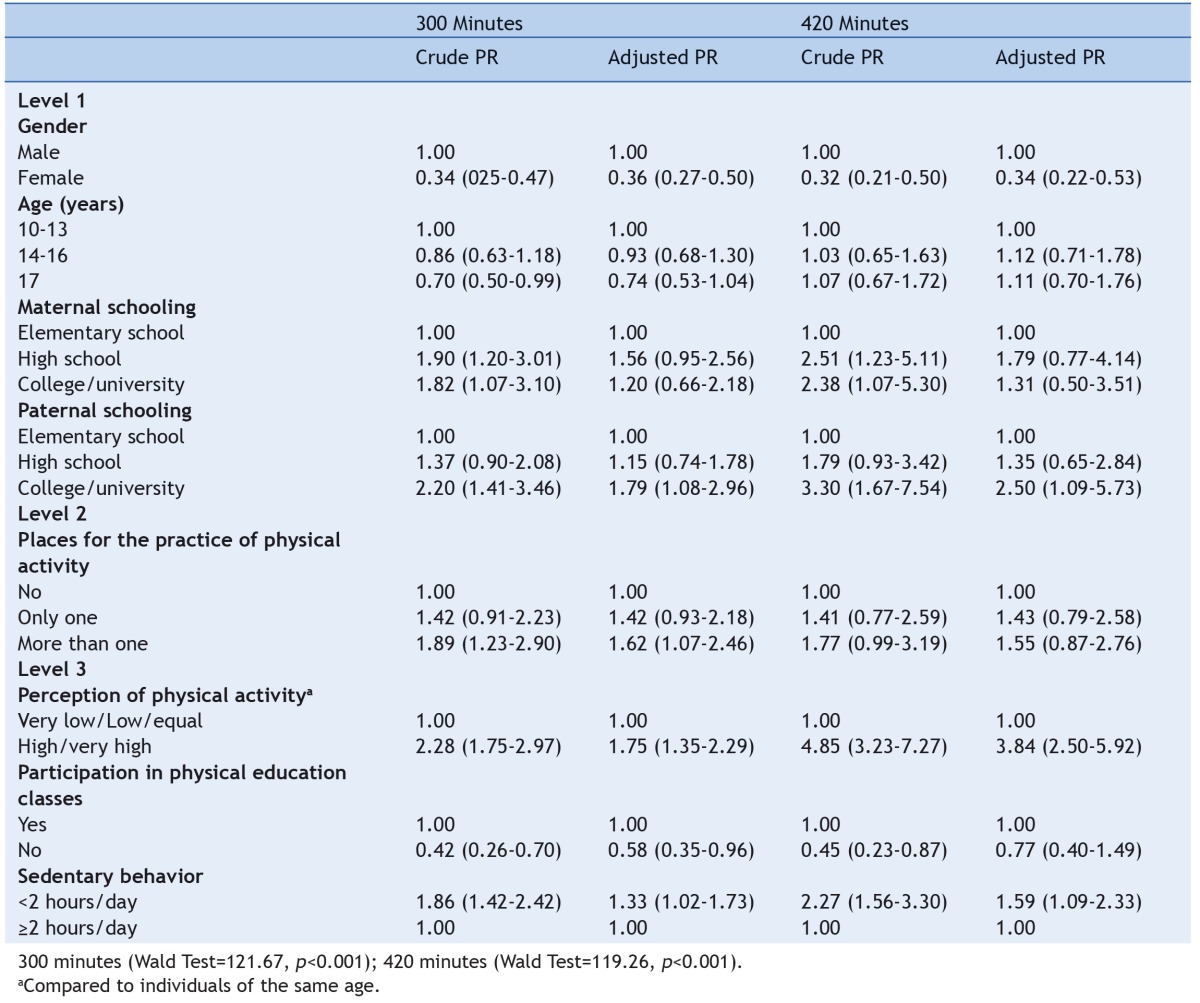
Discussion
The main findings of this study were that the cutoffs for moderate-to-vigorous physical activity of 300 and 420 minutes/week showed strong agreement (90.5% of cases). However, a significant difference (9.5%) was observed in the prevalence of meeting the recommendation. In addition, gender, parental education, perception of physical activity, and sedentary behavior were associated with physical activity in both cutoffs. Conversely, participation in physical education classes and availability of places for physical activity practice were associated with physical activity only when using the cutoff of 300 minutes/week.
The prevalence of individuals who meet the recommendation of moderate-to-vigorous physical activity weekly was found to be 22.1% for 300 minutes and 12.6% for 420 minutes. The results are within the range observed in other studies that used 300 minutes as the cutoff point (14.5% to 50%),6 - 12 but lower than those found when the cutoff point used was 420 minutes, which ranged from 15 to 49.5%.13 , 15 , 18
A noteworthy result is that when comparing the prevalence rates of compliance with the recommendation of physical activity using the cutoffs of 300 and 420 minutes, a significant difference was observed. These data demonstrate that, along with other factors such as sample characteristics and type of assessment tool used,20 the cutoff alone significantly influences the prevalence value of physical activity in young individuals.
Regarding factors associated with physical activity, the present results demonstrate that, in the adjusted analysis, physical activity (300 and 420 minutes) was associated with gender, paternal educational level, perception of physical activity, and sedentary behavior, while participation in physical education classes and availability of places for the practice of physical activity were associated only to the cutoff of 300 minutes. Factors associated with physical activity are broadly debatable, given that the results from different studies are contradictory. Those found in the present study corroborate several studies that have demonstrated a positive association between physical activity and male gender,7 , 9 , 10 , 13 paternal education,8 , 24 perception of physical activity,25 availability of places for physical activity practice,6 , 26 participation in physical education classes,7 - 9 and sedentary behavior.9 , 11 , 13
However, other studies have observed the opposite, i.e., that physical activity is not associated with paternal education, 10 , 11 participation in physical education classes,12 nor sedentary behavior;12 that 40% of adolescents overestimate their physical activity;27 and that it is not associated with the number of leisure facilities for females.6
In spite of the discrepancies found in literature, there is a greater amount of evidence indicating that physical activity is associated with male gender, paternal education, perceived physical activity, participation in physical education classes, and sedentary behavior, and that the difference in results can be partly explained by the characteristics of the studied samples. Thus, it is suggested that the results of each study should only be generalized to similar samples.
Regardless of the factors found to be associated with physical activity, the present study's main objective was to assess whether such factors among adolescents are the same when the two cutoffs used in the literature (300 and 420 min/week) are applied. The results indicated that, of the ten factors analyzed, there was agreement between the criteria in eight, with associations found between physical activity and gender, paternal educational level, perception of physical activity, and sedentary behavior. This suggests that, when analyzing different volumes of activity within the recommended range for young individuals, these factors are appropriate to predict physical activity in this age group. Thus, when analyzing these variables, both cutoffs can be used in epidemiological studies.
However, participation in physical education classes and the availability of places for physical activity practice did not remain associated with physical activity when the cutoff of 420 minutes/week was used, suggesting that, although within the recommended range, higher volumes of physical activity are independent from these factors. Therefore, they should be used cautiously in epidemiological studies, as the association between physical activity and participation in physical education classes and availability of places for physical activity practice depend on the cutoff used. Possibly, for higher volumes of physical activity, in addition to the variables analyzed in this study, other factors may be determinant, such as health status, self-efficacy, motivation, and urban planning.28
Regarding the amount of physical activity required to produce health benefits, it has been described that a volume of moderate-to-vigorous physical activity ≥55 minutes/ day (385 minutes/week) discriminates normal weight adolescents from overweight, whereas ≥49 minutes/day (343 minutes/week) discriminates those with normal percentage of body fat from those with excess body fat,29 values similar to those found by Wittmeyer30 (45 minutes/ day, resulting in 315 minutes/week). Similarly, values of at least 52 minutes/day (364 minutes/week) for boys and 51 minutes/day (357 minutes/week) for girls prevent low cardiorespiratory fitness in adolescents.30 Higher values were found in a recent study, which demonstrated that the minimum amount of moderate to vigorous physical activity to prevent overweight in children was 67 minutes/day (469 minutes/week) when the analyzed outcome was BMI and percentage of body fat, and 47 minutes/day (329 minutes/ week) when the outcome was waist circumference.31
For girls, the required amount was 57 minutes/day (399 minutes/week).31 However, Morrow et al 5 demonstrated that adolescents who meet the recommendation of 420 minutes/week of moderate to vigorous physical activity were three times more likely to meet the grouped criteria for cardiorespiratory fitness, muscle strength, and BMI.
The results of the present study demonstrate that some factors associated with physical activity are modified according to the cutoff used, which suggests standardizing the criteria used in epidemiological studies. However, the choice of a cutoff in such studies should be based on the capacity of these cutoffs to diagnose health-related out-comes. Regarding physical activity, this becomes difficult, considering that the available evidence shows health benefits with amounts within the range of 300 to 469 minutes/ week, the fact that benefits can be linear, and that the necessary amount of physical activity is different for different aspects of health.5 , 29 - 31
The present study had some limitations that should be considered. First, although there is a more accurate method to estimate physical activity, for instance, using accelerometry in epidemiological studies, the questionnaire is a more practical method and has been widely used. In addition, other predictors of physical activity, such as motivational factors and urban planning, were not analyzed, and it is not possible to identify whether the factors that have a causal association with physical activity are associated differently according to the cutoff used. Finally, the study sample did not provide sufficient power to detect the association between physical activity and places available for physical activity practice when using the cutoff of 420 minutes, as well as to conduct the analysis stratified by gender and age. It is suggested that future studies assess the association of the criteria for physical activity in young individuals according to gender and age.
In conclusion, although the agreement between the cutoffs of 300 and 420 minutes/week in young individuals is considered strong, the prevalence of physical activity found in the two cutoffs was significantly different. Regarding associated factors, gender, paternal education, perceived physical activity, and sedentary behavior were associated with physical activity in both cutoffs. However, participation in physical education classes and the places available for physical activity practice were only associated with the cutoff for physical activity of 300 minutes/week. The results suggest caution when using cutoffs for physical activity of 300 and 420 minutes/week in young individuals, as, although both are within the recommended range for this age group, they result in different prevalence values. Similarly, the association between the factors participation in physical education classes and available places to practice physical activity depends on the cutoff used. Thus, care must be taken when analyzing the factors associated with physical activity in young individuals and when applying predictive models resulting from studies that used different cutoffs.
Footnotes
Study conducted at Universidade Estadual de Londrina, Londrina, PR, Brazil.
Referências
- 1.Lloyd-Jones DM, Hong Y, Labarthe D, Mozaffarian D, Appel LJ, Van Horn L, et al. Defining and setting national goals for cardiovascular health promotion and disease reduction: the American heart association's strategic impact goal through 2020 and beyond. Circulation. 2010;121:586–613. doi: 10.1161/CIRCULATIONAHA.109.192703. [DOI] [PubMed] [Google Scholar]
- 2.World Health organization . Global recommendations on physical activity for health. Geneva: WHO; 2010. [PubMed] [Google Scholar]
- 3.Ekelund U, Luan J, Sherar LB, Esliger DW, Griew P, Cooper A, et al. Moderate to vigorous physical activity and sedentary time and cardiometabolic risk factors in children and adolescents. JAMA. 2012;307:704–712. doi: 10.1001/jama.2012.156. [DOI] [PMC free article] [PubMed] [Google Scholar]
- 4.Kremer P, Elshaug C, Leslie E, Toumbourou JW, Patton GC, Williams J. Physical activity, leisure-time screen use and depression among children and young adolescents. J Sci Med Sport. 2013 Mar 12; doi: 10.1016/j.jsams.2013.03.012. Epub. [DOI] [PubMed] [Google Scholar]
- 5.Morrow JR, Jr, Tucker JS, Jackson AW, Martin SB, Greenleaf CA, Petrie TA. Meeting physical activity guidelines and health Related fitness in youth. Am J Prev Med. 2013;44:439–444. doi: 10.1016/j.amepre.2013.01.008. [DOI] [PubMed] [Google Scholar]
- 6.Lima AV, Fermino RC, Oliveira MP, Añez CR, Reis RS. Perceived distance to recreational and the association with physical activity and exercise among adolescents in Curitiba, Paraná state, Brazil. Cad Saude Publica. 2013;29:1507–1521. doi: 10.1590/0102-311x00175912. [DOI] [PubMed] [Google Scholar]
- 7.Tenório MC, Barros MV, Tassitano RM, Bezerra J, Tenório JM, Hallal PC. Physical activity and sedentary behavior among adolescent high school students. Rev Bras Epidemiol. 2010;13:105–117. doi: 10.1590/s1415-790x2010000100010. [DOI] [PubMed] [Google Scholar]
- 8.Farias JC, Júnior, Lopes Ada S, Mota J, Hallal PC. Physical activity practice and associated factors in adolescents in Northeastern Brazil. Rev Saude Publica. 2012;46:505–515. doi: 10.1590/s0034-89102012005000031. [DOI] [PubMed] [Google Scholar]
- 9.Ceschini FL, Andrade DR, Oliveira LC, Araújo JF, Junior, Matsudo VK. Prevalence of physical inactivity and associated factors among high school students from state's public schools. J Pediatr (Rio J) 2009;85:301–306. doi: 10.2223/JPED.1915. [DOI] [PubMed] [Google Scholar]
- 10.Fermino RC, Rech CR, Hino AA, Rodriguez Añez CR, Reis RS. Physical activity and associated factors in high-school adolescents in Southern Brazil. Rev Saude Publica. 2010;44:986–995. doi: 10.1590/s0034-89102010000600002. [DOI] [PubMed] [Google Scholar]
- 11.Dumith SC, Domingues MR, Gigante DP, Hallal PC, Menezes AM, Kohl HW. Prevalence and correlates of physical activity among adolescents from Southern Brazil. Rev Saude Publica. 2010;44:457–467. doi: 10.1590/s0034-89102010000300009. [DOI] [PubMed] [Google Scholar]
- 12.Silva KS, Nahas MV, Peres KG, Lopes AS. Factors associated with physical activity, sedentary behavior, and participation in physical education among high school students in Santa Catarina state, Brazil. Cad Saude Publica. 2009;25:2187–2200. doi: 10.1590/s0102-311x2009001000010. [DOI] [PubMed] [Google Scholar]
- 13.Barbosa VC, Filho, Campos W, Bozza R, Lopes AS. The prevalence and correlates of behavioral risk factors for cardiovascular health among Southern Brazil adolescents: a cross-sectional study. BMC Pediatr. 2012;25:12–130. doi: 10.1186/1471-2431-12-130. [DOI] [PMC free article] [PubMed] [Google Scholar]
- 14.Farias JC, Júnior, Siqueira FV, Nahas MV, Barros MV. Prevalence and associated factors to insufficient level physical activity and in youth from two city of Brazil: last seven days or typical week. Rev Bras Educ Fis Esporte. 2011;25:619–629. [Google Scholar]
- 15.Dumith SC, Muniz LC, Tassitano RM, Hallal PC, Menezes AM. Clustering of risk factors for chronic diseases among adolescents from Southern Brazil. Prev Med. 2012;54:393–396. doi: 10.1016/j.ypmed.2012.03.014. [DOI] [PMC free article] [PubMed] [Google Scholar]
- 16.Dumith SC, Gigante DP, Domingues MR, Hallal PC, Menezes AM, Kohl 3rd HW. Predictors of physical activity change during adolescence: a 3.5-year follow-up. Public Health Nutr. 2012;15:2237–2245. doi: 10.1017/S1368980012000948. [DOI] [PMC free article] [PubMed] [Google Scholar]
- 17.Mitchell JA, Pate RR, España-Romero V, O'Neill JR, Dowda M, Nader PR. Moderate-To vigorous physical activity is associated with decreases in body mass index from ages 9 to 15 years. Obesity (Silver Spring) 2013;21:E280–E293. doi: 10.1002/oby.20118. [DOI] [PubMed] [Google Scholar]
- 18.Song M, Carroll DD, Fulton JE. Meeting the 2008 physical activity guidelines for Americans among U.S. youth. Am J Prev Med. 2013;44:216–222. doi: 10.1016/j.amepre.2012.11.016. [DOI] [PubMed] [Google Scholar]
- 19.Jose KA, Blizzard L, Dwyer T, McKercher C, Venn AJ. Childhood and adolescent predictors of leisure time physical activity during the transition from adolescence to adulthood: a population based cohort study. Int J Behav Nutr Phys Act. 2011;8:54–54. doi: 10.1186/1479-5868-8-54. [DOI] [PMC free article] [PubMed] [Google Scholar]
- 20.Barufaldi LA, Abreu GA, Coutinho ES, Bloch KV. Meta-analysis of the prevalence of physical inactivity among Brazilian adolescents. Cad Saude Publica. 2012;28:1019–1032. doi: 10.1590/s0102-311x2012000600002. [DOI] [PubMed] [Google Scholar]
- 21.Baecke JA, Burema J, Frijters JE. A short questionnaire for the measurement of habitual physical activity in epidemiological studies. Am J Clin Nutr. 1982;36:936–942. doi: 10.1093/ajcn/36.5.936. [DOI] [PubMed] [Google Scholar]
- 22.Associação Brasileira de Empresas de Pesquisa [cited 2012 Apr 12];Critério de Classificação Econômica do Brasil, 2012. [homepage on the Internet] Available from: http://www.abep.org.
- 23.Tremblay MS, Leblanc AG, Janssen I, Kho ME, Hicks A, Murumets K, et al. Canadian sedentary behaviour guidelines for children and youth. Appl Physiol Nutr Metab. 2011;36:59–64. doi: 10.1139/H11-012. [DOI] [PubMed] [Google Scholar]
- 24.Jiménez-Pavón D, Fernández-Alvira JM, te Velde SJ, Brug J, Bere E, Jan N, et al. Associations of parental education and parental physical activity (PA) with children's PA: the ENERGY cross-sectional study. Prev Med. 2012;55:310–314. doi: 10.1016/j.ypmed.2012.07.011. [DOI] [PubMed] [Google Scholar]
- 25.Crocker PR, Eklund RC, Kowalski KC. Children's physical activity and physical self-perceptions. J Sports Sci. 2000;18:383–394. doi: 10.1080/02640410050074313. [DOI] [PubMed] [Google Scholar]
- 26.Floyd MF, Bocarro JN, Smith WR, Baran PK, Moore RC, Cosco Ng, et al. Park-based physical activity among children and adolescents. Am J Prev Med. 2011;41:258–265. doi: 10.1016/j.amepre.2011.04.013. [DOI] [PubMed] [Google Scholar]
- 27.Corder K, Van Sluijs EM, McMinn AM, Ekelund U, Cassidy A, Griffin SJ. Perception versus reality awareness of physical activity levels of British children. Am J Prev Med. 2010;38:1–8. doi: 10.1016/j.amepre.2009.08.025. [DOI] [PMC free article] [PubMed] [Google Scholar]
- 28.Bauman AE, Reis RS, Sallis JF, Wells JC, Loos RJ, Martin BW, et al. Correlates of physical activity: why are some people physically active and others not? Lancet. 2012;380:258–271. doi: 10.1016/S0140-6736(12)60735-1. [DOI] [PubMed] [Google Scholar]
- 29.Martinez-Gomez D, Ruiz JR, Ortega FB, Casajús JA, Veiga OL, Widhalm K, et al. Recommended levels and intensities of physical activity to avoid low-cardiorespiratory fitness in European adolescents: the Helena study. Am J Hum Biol. 2010;22:750–756. doi: 10.1002/ajhb.21076. [DOI] [PubMed] [Google Scholar]
- 30.Wittmeier KD, Mollard RC, Kriellaars DJ. Physical activity intensity and risk of overweight and adiposity in children. Obesity (Silver Spring) 2008;16:415–420. doi: 10.1038/oby.2007.73. [DOI] [PubMed] [Google Scholar]
- 31.Laguna M, Ruiz JR, Lara MT, Aznar S. Recommended levels of physical activity to avoid adiposity in Spanish children. Pediatr Obes. 2013;8:62–69. doi: 10.1111/j.2047-6310.2012.00086.x. [DOI] [PubMed] [Google Scholar]



